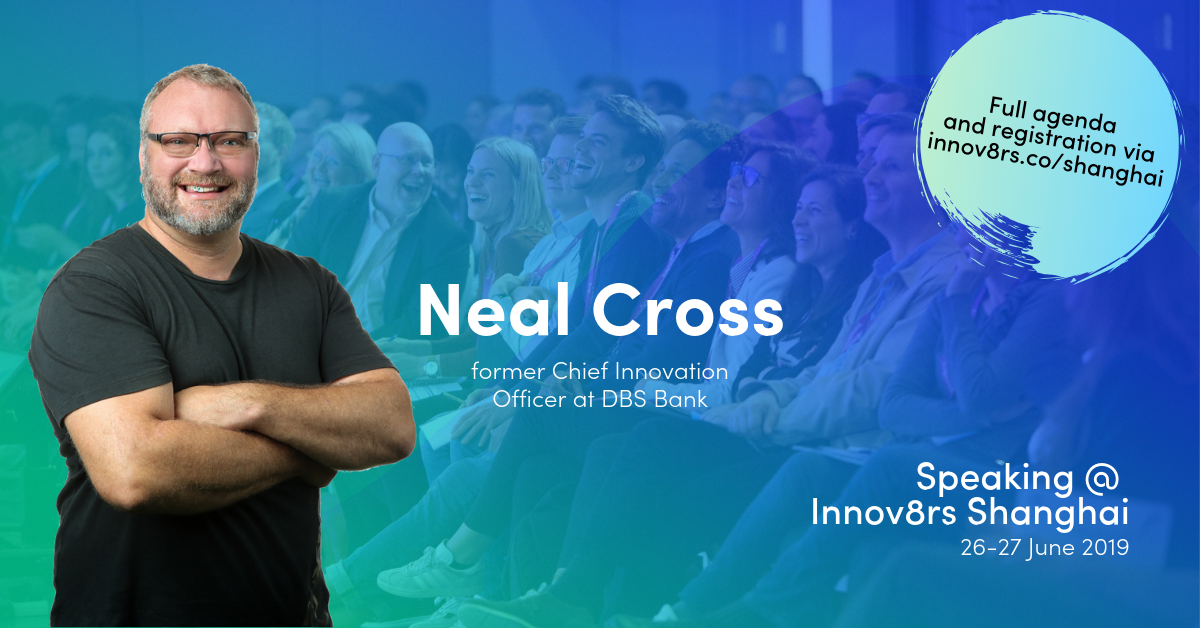Corporate innovation often isolates or alienates those who are best-placed to solve real problems.
 We called upon the wisdom of Neal Cross to explain why innovators need to stop innovating to focus on doing better by those around them, and how he turned the conventional corporate innovation model upside down to shape the future of digital banking.
We called upon the wisdom of Neal Cross to explain why innovators need to stop innovating to focus on doing better by those around them, and how he turned the conventional corporate innovation model upside down to shape the future of digital banking.
Formerly the CIO of DBS Bank, Neal has won awards for driving industry-level disruption. Between advising fintech start-ups in Asia about the future, he now builds social enterprise hotels in Sumatra to help save the endangered Orangutan.
He is also bringing his famed candor to Innov8rs Shanghai (26-27 June) to blow the cobwebs from the corporate innovation landscape, building on his biggest career learnings to offer an alternative formula for success with corporate innovation.
What does that formula look like?
A pinch of persistence
It takes time for truly exceptional change to take root. That’s why bringing a culture of innovation not to several hundred technologists and SMEs in a lab, but to an entire banking group of 25,000, takes determination:
‘For any transformation like this, it takes time, a singular focus, and a lot of effort.
Culture is like a rubber band: You need to keep engaging and stretching your workforce to think and do differently – to achieve divergent outcomes. If you stop pushing, people and their mindsets go back to their natural shape.
So you have to keep pushing at the right speed, and then once you’re there and you’ve stretched your company to the right shape – pin it in place, with corporate governance, KPIs, steering committees, CEO and board messaging.’
The drive to be unusual
Coming up with cool, novel ideas isn’t enough to shapeshift business value, and this is why root-and-branch reform is needed to make corporates into truly impactful drivers of innovation.
For Neal Cross in his reinvention of corporate innovation at DBS, the problem lay in the role of corporate innovators themselves:
‘To be a corporate innovator, you end up stepping on other people’s toes by the role’s very definition.
For example, you create the buzz for exciting PR – there’s a marketing team for that.
You prototype a great new product – this should be done by the product delivery team.
You look into leading-edge technology to deliver results – then what are your tech team doing?’
This is where common thinking took a backseat to make way for a brave new world not of creators, but of enablers and communicators – a group of innovation leaders who were designed to never truly invent anything.
Why did this strategy work? The onus for innovation sat with those who had the problems in the first place… the business.
Because despite all the gushing talk of moon-shot projects, tinkering with technology and mirroring the customer’s every move, it is really those who experience the day-to-day challenges at their coalface who are best positioned to validate and solve them.
The will to be world-class
Neal attributes his success in corporate innovation to those around him.
By inspiring those he works with to do their career’s best work, to be more ambitious, operate outside of assumptions, and take care and pride over what they do – there is no limit to how far products, solutions, and people can go, or how much better they can be.
What made him into a world-class leader? And what made his teams into world-class innovators?
‘I do four things.
I give protection to my team: anything that happens is always my fault. The team knows that this is a safe space to fail, so they can push towards their ambitions.
I give them freedom because I trust them. Certain things need to be delivered from a corporate objectives perspective, but for the rest – they can do exactly as they please, from creating new concepts to building programs and talking to start-ups.
Thirdly, education: this means not only teaching classic innovation methodologies like agile and rapid prototyping – but other fundamental skills for a well-rounded understanding of moving ideas forward, like advertising and sales.
And lastly, inspiration. Everything I do needs to be world-class in that it’s a star-shot, not a moon-shot, so it never comes crashing back down to earth – it always lands somewhere much higher. I lead by example.’
The way to do this is through understanding your benchmarks; measuring what success looks like through the lens of what already exists, to make a better version.
There’s a toxic self-limitation built into many of us, which hampers our self-belief, growth, and ability to game what’s already out there to create something truly world-class.
Killing limitations
The secret to this relentless can-do attitude is to work backward: first, assume that anything is possible. Second, trace through the steps to work out whether it’s worth the time, effort, and resources required to make it happen.
To do make this work, you don’t just need to know what ‘groundbreaking’ looks like, but what ‘good’ and ‘the best’ look like. Who’s already doing it best? Do you want to exceed this, and is it worth it?
Particularly in financial services, ‘impossible’ is often just a synonym for ‘hard’, Neal describes:
‘The invisible shackles imposed by industry regulation make things difficult, not impossible. And the too-frequent assertion that ‘we can’t do this, we can’t do that’ is simply a product of self-limitation… the real problem is the limitations we set for ourselves, not the rules that the ‘bank’ enforces.
If you remove the shackles of self-limitation to create 10 world-class ideas, I can almost guarantee you would have 8 above average ideas, one pretty special idea, and one spectacular idea.
Great innovation is born from constraints, not whilst you’re having a nap. Often people give up too easily.’
Unsung skills in innovation
Nor is it the ideas which are the special part.
Innovation, Neal reiterates, is all about being critical about finding the right problem, and being a catalyst for meaningful change, by helping other people to achieve great things.
Many corporate innovators turn a blind eye to basic corporate politics.
‘Imagine I invented this amazing payments system. I go to the head of payments and show them:
“Look at what I’ve created. It’s amazing. We should put it into production, right?”
What have I just told the head of payments? I’ve told them that they’re not doing their job properly and that everyone is going to know about it.
Because of this, they think “that’s never going into production”, and beyond that, “I need to start discrediting Neal because he’s a danger to my career.”’
This is why organization-wide support for innovation isn’t a given – it’s earned. And this doesn’t require the need for eccentricity, creativity, in-depth technical knowledge, and world-class ideas – it requires excellent sales and marketing:
‘I don’t innovate: I spend my time creating buy-in. Politics and building firm friends are underplayed and undervalued skills in corporate innovation – because all things considered, you can never go far wrong if you help someone really senior achieve their bonus.
For this, a background in sales helps, and the persistence to do the pre-work. Growing from three people, a desk and no funding to creating 25,000 corporate innovators comes largely from building the right relationships.’
Long gone is the myth that only cool companies on the west coast of the US have mastered the game of innovation; it’s happening on the east coast of China – and across the world.
Many corporates now have the technological nous, the datasets and computing networks, the freewheeling corporate culture and collective ambition to ‘put a dent in the universe’, as Apple’s co-founder Steve Jobs had it.
But perhaps what we really need is not a disruptive mess of shiny things, masses of ideas and tech evangelists, but the oft-forgotten people skills, problem validations and a focus on building frameworks which will enable others to do great work.
‘Stop innovating, and stop inventing things – start putting alliances in place to solve the right problem, and start a movement.’
______


